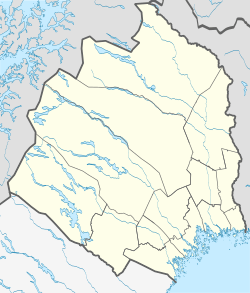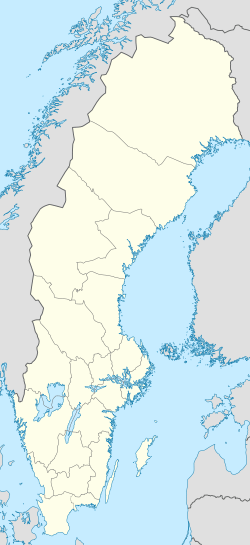Karesuando facts for kids
Quick facts for kids
Karesuando (Swedish)
|
|
|---|---|

Karesuando Church in August 2005
|
|
| Country | Sweden |
| Province | Lapland |
| County | Norrbotten County |
| Municipality | Kiruna Municipality |
| Area | |
| • Total | 0.93 km2 (0.36 sq mi) |
| Population
(31 December 2010)
|
|
| • Total | 300 |
| • Density | 324/km2 (840/sq mi) |
| Time zone | UTC+1 (CET) |
| • Summer (DST) | UTC+2 (CEST) |
Karesuando is the northernmost village in Sweden. It is located in Kiruna Municipality, in Norrbotten County. About 300 people live there.
The village sits right next to the Muonio River. This river forms the border between Sweden and Finland. On the Finnish side of the river, there is another village also called Karesuvanto. Even though they share a name and are very close, they are usually seen as separate villages. This is because a national border runs between them.
History of Karesuando
The first buildings in Karesuando were built in 1670. A man named Måns Mårtensson Karesuando bought land from the Sami people.
The first church in Karesuando was built in 1816. Before this, the local church was on the Finnish side of the border. The border between Sweden and Finland was created in 1809. This meant a new church was needed on the Swedish side.
A famous vicar and botanist named Lars Levi Laestadius lived in Karesuando. He served the church from 1826 to 1849. While he was there, he started a religious movement called Laestadianism. This movement is still active today.
The people in this area traditionally spoke Finnish. The border was drawn for political reasons in 1809. It did not follow any existing cultural or language lines. Over time, schools and churches have led to some cultural and language differences between the two sides.
During World War II, Karesuando was used as a training camp. Norwegian police troops trained here.
Getting Around Karesuando
Karesuando is located along a major road called European route E45. This road helps people travel across Europe. Karesuando is also the very northern end of Swedish national road 99.
Climate and Nature
Karesuando has a subarctic climate. This means it has short, cool summers. The winters are long, cold, and sometimes very cold. Snowfall can change each year. It is often not too heavy because the air is very dry. However, the snow stays on the ground all winter. This is because the temperatures are so cold.
Summers in Karesuando get a good amount of rain. Since Karesuando is far from the coast, it can get very warm for short times. But temperatures can also drop to -40 degrees Celsius (or Fahrenheit). Even with this cold, the North Atlantic Current helps. This ocean current makes winters less severe than in some other places at the same latitude.
Because Karesuando is so far north, it experiences midnight sun and polar night.
- During the midnight sun, the sun stays visible for 24 hours a day in summer.
- During the polar night, the sun does not rise above the horizon in winter.
The UV index in summer is low. This is also because of its far northern location. Karesuando itself is below the arctic tree line. This means trees can still grow there. However, north of Karesuando, on the Finnish side, you will find mostly bushes and small taiga forests. To the south, west, and east, you will find larger boreal forests. Higher areas nearby are tundra, where only small plants grow.
The amount of snow on the ground is usually not very deep. This is because winters are quite dry.
| Climate data for Karesuando (2002–2020 averages; sunshine for Kiruna 1961–1990; extremes since 1901) | |||||||||||||
|---|---|---|---|---|---|---|---|---|---|---|---|---|---|
| Month | Jan | Feb | Mar | Apr | May | Jun | Jul | Aug | Sep | Oct | Nov | Dec | Year |
| Record high °C (°F) | 7.2 (45.0) |
6.2 (43.2) |
10.5 (50.9) |
15.8 (60.4) |
28.2 (82.8) |
32.2 (90.0) |
32.5 (90.5) |
29.1 (84.4) |
24.0 (75.2) |
16.0 (60.8) |
9.0 (48.2) |
6.5 (43.7) |
32.5 (90.5) |
| Mean maximum °C (°F) | 1.7 (35.1) |
2.5 (36.5) |
4.5 (40.1) |
9.8 (49.6) |
20.5 (68.9) |
24.7 (76.5) |
25.5 (77.9) |
24.3 (75.7) |
18.2 (64.8) |
9.8 (49.6) |
3.4 (38.1) |
2.6 (36.7) |
27.1 (80.8) |
| Mean daily maximum °C (°F) | −9.7 (14.5) |
−8.2 (17.2) |
−3.0 (26.6) |
2.9 (37.2) |
9.5 (49.1) |
15.5 (59.9) |
19.2 (66.6) |
16.5 (61.7) |
10.7 (51.3) |
2.2 (36.0) |
−3.9 (25.0) |
−6.5 (20.3) |
3.8 (38.8) |
| Daily mean °C (°F) | −14.6 (5.7) |
−13.2 (8.2) |
−8.3 (17.1) |
−1.8 (28.8) |
4.8 (40.6) |
10.6 (51.1) |
14.2 (57.6) |
11.7 (53.1) |
6.6 (43.9) |
−1.0 (30.2) |
−7.8 (18.0) |
−11.0 (12.2) |
−0.8 (30.5) |
| Mean daily minimum °C (°F) | −19.5 (−3.1) |
−18.1 (−0.6) |
−13.6 (7.5) |
−6.5 (20.3) |
0.1 (32.2) |
5.7 (42.3) |
9.1 (48.4) |
6.8 (44.2) |
2.5 (36.5) |
−4.2 (24.4) |
−11.7 (10.9) |
−15.5 (4.1) |
−5.4 (22.3) |
| Mean minimum °C (°F) | −35.4 (−31.7) |
−34.4 (−29.9) |
−29.4 (−20.9) |
−20.1 (−4.2) |
−7.2 (19.0) |
−0.3 (31.5) |
2.8 (37.0) |
−0.8 (30.6) |
−5.2 (22.6) |
−16.9 (1.6) |
−26.9 (−16.4) |
−30.5 (−22.9) |
−38.0 (−36.4) |
| Record low °C (°F) | −49.0 (−56.2) |
−48.1 (−54.6) |
−42.8 (−45.0) |
−36.5 (−33.7) |
−22.0 (−7.6) |
−4.0 (24.8) |
−1.0 (30.2) |
−4.6 (23.7) |
−12.0 (10.4) |
−28.6 (−19.5) |
−38.0 (−36.4) |
−42.0 (−43.6) |
−49.0 (−56.2) |
| Average precipitation mm (inches) | 29.7 (1.17) |
23.9 (0.94) |
16.5 (0.65) |
18.8 (0.74) |
39.4 (1.55) |
64.8 (2.55) |
82.2 (3.24) |
64.2 (2.53) |
47.6 (1.87) |
33.9 (1.33) |
30.9 (1.22) |
34.8 (1.37) |
486.7 (19.16) |
| Average extreme snow depth cm (inches) | 47 (19) |
61 (24) |
61 (24) |
58 (23) |
24 (9.4) |
0 (0) |
0 (0) |
0 (0) |
1 (0.4) |
13 (5.1) |
24 (9.4) |
41 (16) |
65 (26) |
| Mean monthly sunshine hours | 5 | 62 | 139 | 183 | 232 | 266 | 243 | 159 | 110 | 67 | 18 | 0 | 1,484 |
See also
 In Spanish: Karesuando para niños
In Spanish: Karesuando para niños



